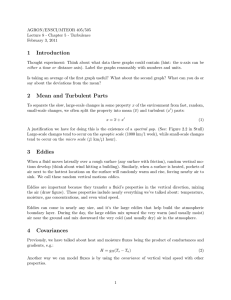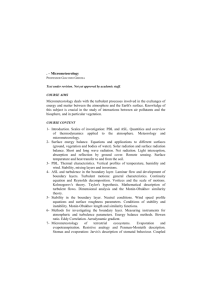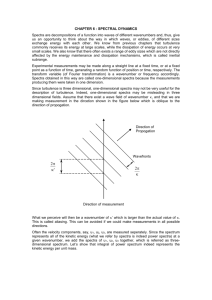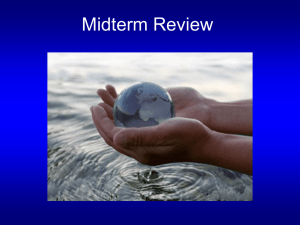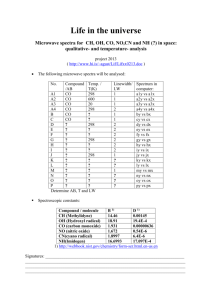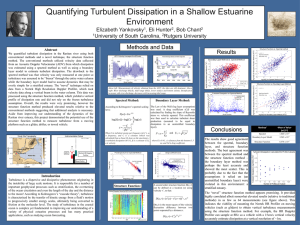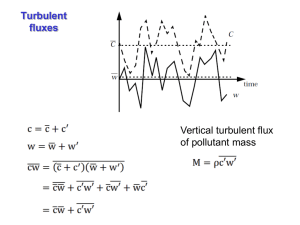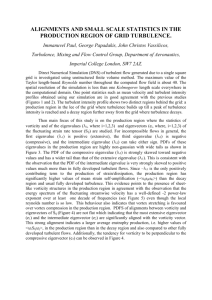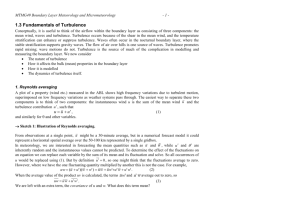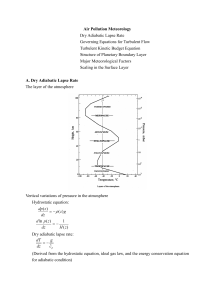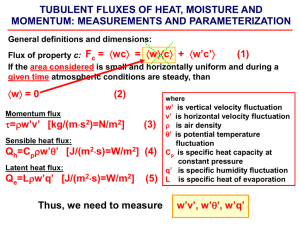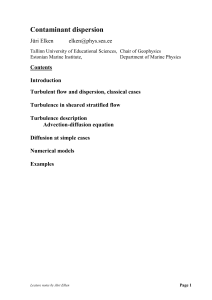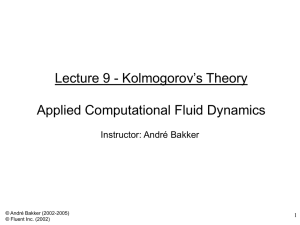2.5 Turbulence Spectra - University of Reading
advertisement
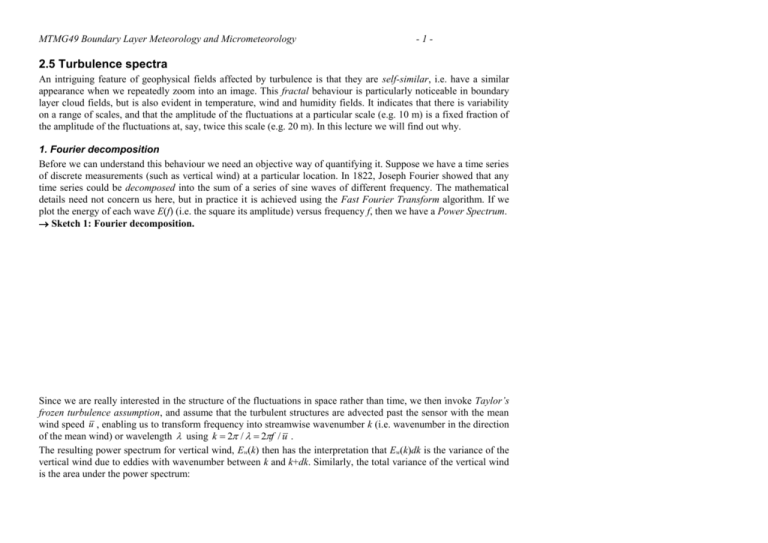
MTMG49 Boundary Layer Meteorology and Micrometeorology -1- 2.5 Turbulence spectra An intriguing feature of geophysical fields affected by turbulence is that they are self-similar, i.e. have a similar appearance when we repeatedly zoom into an image. This fractal behaviour is particularly noticeable in boundary layer cloud fields, but is also evident in temperature, wind and humidity fields. It indicates that there is variability on a range of scales, and that the amplitude of the fluctuations at a particular scale (e.g. 10 m) is a fixed fraction of the amplitude of the fluctuations at, say, twice this scale (e.g. 20 m). In this lecture we will find out why. 1. Fourier decomposition Before we can understand this behaviour we need an objective way of quantifying it. Suppose we have a time series of discrete measurements (such as vertical wind) at a particular location. In 1822, Joseph Fourier showed that any time series could be decomposed into the sum of a series of sine waves of different frequency. The mathematical details need not concern us here, but in practice it is achieved using the Fast Fourier Transform algorithm. If we plot the energy of each wave E(f) (i.e. the square its amplitude) versus frequency f, then we have a Power Spectrum. Sketch 1: Fourier decomposition. Since we are really interested in the structure of the fluctuations in space rather than time, we then invoke Taylor’s frozen turbulence assumption, and assume that the turbulent structures are advected past the sensor with the mean wind speed u , enabling us to transform frequency into streamwise wavenumber k (i.e. wavenumber in the direction of the mean wind) or wavelength using k 2 / 2f / u . The resulting power spectrum for vertical wind, Ew(k) then has the interpretation that Ew(k)dk is the variance of the vertical wind due to eddies with wavenumber between k and k+dk. Similarly, the total variance of the vertical wind is the area under the power spectrum: MTMG49 Boundary Layer Meteorology and Micrometeorology -2- w 2 w 2 E w (k )dk . 0 This is known as Parseval’s theorem. From the definition of turbulent kinetic energy (TKE) in lecture 1.4 as half the sum of the variances of the three wind components, you can see how we can decompose TKE into a spectrum. Ew(k) has units of energy per unit mass per unit wavenumber, i.e. N kg-1 (m-1)-1 or m3 s-2. 2. The turbulent energy cascade We now have the tools to discuss the nature of the turbulent kinetic energy spectrum, shown schematically in Fig. 1. It typically has three distinct regions: A. The energy-producing range, where TKE is produced by buoyancy or shear, and the fluctuations have a characteristic size of order the integral length scale . For a convective boundary layer, would be around the depth of the boundary layer, while for shear production it would be around the wavelength of the developing Kelvin-Helmholtz waves. B. The inertial subrange, where energy is neither produced nor dissipated, but it is handed down to smaller and smaller scales. This is known as the turbulent energy cascade, and is an example of the second law of thermodynamics acting to increase the entropy of the universe. It is due to the non-linear nature of the Navier-Stokes equations in which waves at different scales interact. The turbulence in this region is 3D and isotropic (i.e. the structures have no preferred orientation). C. The dissipation range, where the kinetic energy of parcels of air is converted into the kinetic energy of air molecules, i.e. TKE is dissipated into heat. The length scale below which this occurs depends only on the TKE dissipation rate ( and the molecular viscosity (). On dimensional grounds it must therefore be given by =. It is known as the Kolmogorov microscale and is typically around 1 mm. E(k)~k- Figure 1. Schematic of a turbulent energy spectrum in the ABL, showing (A) the region of energy production, (B) the inertial subrange and (C) the dissipation region. From Kaimal and Finnigan (1994). 3. Kolmogorov similarity theory The range of scales over which self-similar behaviour is seen is clearly the inertial subrange. In 1941, Kolmogorov hypothesized that in this region the turbulent energy spectrum E(k) (in m3 s-2) depends only on the wavenumber k (in m-1) and the dissipation rate (in m2 s-3). What is the only dimensionally correct expression for E(k)? The decrease in the amplitude of the fluctuations at smaller scales is an example of a red noise process, and indicates that there is some correlation between adjacent values in a time series. By contrast, if the values in a time MTMG49 Boundary Layer Meteorology and Micrometeorology -3- series are completely uncorrelated with each other then the corresponding power spectrum would be flat; this is known as white noise. It is remarkable that this relationship between spectral energy and wavenumber is observed not only for the three components of wind, but also for scalar fields advected by the wind (temperature, humidity, cloud water content and pollution concentration) and indeed in turbulent phenomena in astrophysics, geophysics and engineering. It is even more surprising that no-one has managed to derive this relationship from first principles, i.e. from the governing Navier-Stokes equations. 4. Clouds in alternative universes The fractal appearance of clouds is entirely due to turbulence. To visualize the effect that the exponent of the power law has on geophysical fields, Fig. 2 shows three synthetic cloud fields with exponents of 2/3, 5/3 and 8/3. It can be seen that in a hypothetical universe with a lower value, fields affected by turbulence would have a more speckled appearance, i.e. closer to white noise, while in a universe with a higher value these fields would be smoother. 5. Spectra in the surface layer (non-examinable) In lecture 1.5 we described eddies in the surface layer in terms of a mixing length, i.e. a typical eddy size. In fact, there are a spectrum of eddies present. Figure 3 shows a summary of the spectra obtained from the Kansas Figure 2. Cloud fields generated from synthetic 2D distributions of total water content (vapour plus liquid; a cloud is formed when the total water content exceeds the saturation value) with spectral slopes of 2/3 (left), 5/3 (centre) and 8/3 (right). MTMG49 Boundary Layer Meteorology and Micrometeorology -4- experiment. By normalizing the two axes appropriately, the spectra from a wide range of conditions are found to collapse on to a single family of curves with a shape dependent only on the Monin-Obukhov stability parameter, z / L . Some interesting features are present: The u and w spectra are somewhat different, with more large eddies present in the u spectrum. Larger values of z/L result in a suppression of the larger eddies but the same intensity of smaller eddies. In unstable conditions (z/L<0) the u spectra no longer collapse to a unique curve. This is because the distance above the surface is no longer the dominant length scale; rather the depth of the boundary layer determines the size of the largest eddies. Similar behaviour is observed in the w spectrum for z/L<-0.3. There is a curious excluded region in the u figure separating the spectra for marginally stable conditions from that for marginally unstable conditions. You might think that the peak of the spectra corresponds to the mixing length but it is not that simple. The mixing length is the size of the characteristic eddy that carries heat or momentum, but it turns out that the smaller eddies are not as efficient at turbulent transport. Further reading: Kaimal and Finnigan chapter 2. f Eu(f) / (kz f Ew(f) / (kz Figure 3. Normalized surface layer u and w spectra showing the variation with z/L. These were measured during the Kansas experiment. Figures taken from Kaimal and Finnigan (1994).
